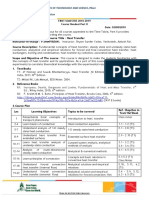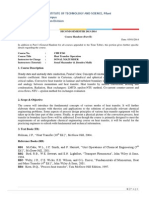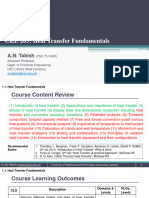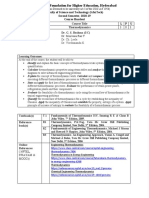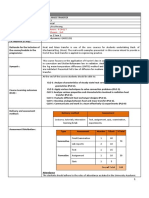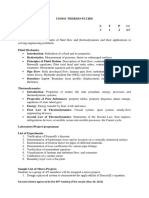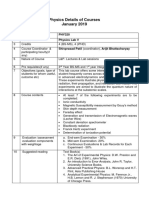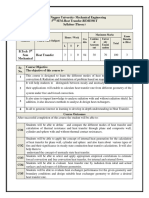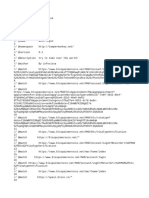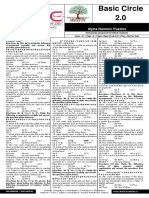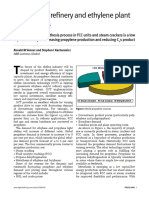Birla Institute of Technology and Science, Pilani: Pilani Campus AUGS/ AGSR Division
Birla Institute of Technology and Science, Pilani: Pilani Campus AUGS/ AGSR Division
Uploaded by
HET DAVE DAVEOriginal Description:
Original Title
Copyright
Available Formats
Share this document
Did you find this document useful?
Is this content inappropriate?
Copyright:
Available Formats
Birla Institute of Technology and Science, Pilani: Pilani Campus AUGS/ AGSR Division
Birla Institute of Technology and Science, Pilani: Pilani Campus AUGS/ AGSR Division
Uploaded by
HET DAVE DAVECopyright:
Available Formats
BIRLA INSTITUTE OF TECHNOLOGY AND SCIENCE, Pilani
Pilani Campus
AUGS/ AGSR Division
SECONDSEMESTER 2023-24
COURSE HANDOUT
Date: 10.01.2024
In addition to part I (General Handout for all courses appended to the Time table) this portion gives
further specific details regarding the course.
Course No. : ME F220, Unit: 3-1-4
Course Title : Heat Transfer
Instructor-in-Charge : SRINIVASAN PERIASWAMY
Tutorial Instructors : Aneesh A.M, Chennu Ranganayakulu and Shivasheesh Kaushik
Practical Instructors: Rahul Bharath, Chandra Shekar Sharma, Krishnaram K K, Neeraj
Kumar Sharma
1. Course Description: The course contents include fundamental concepts of heat transfer; steady state
and unsteady state heat conduction; analytical and empirical relations for forced and free convection
heat transfer; heat exchangers; boiling and condensation; heat transfer by radiation; introduction to
mass transfer; associated laboratory.
2. Scope and Objective of The course: This course is designed to make the students familiarize with
the concepts of heat transfer and its applications. As a part of this course, students have to do the
experiments to correlate theoretical knowledge with the experimental results. The specific objectives
of this course is to understand the fundamental and subsidiary laws of heat transfer, formulate
governing equations for specific heat transfer systems, identify suitable solution methods, develop
the basic problem-solving skills, and analyze the results to develop useful inferences.
3. Text Books
T1: JP Holman and Souvik Bhattacharyya, Heat Transfer (SI Edition), McGraw Hill Education,
India, 2011,10th Edition.
4. Reference Books
R1: Incropera, Dewitt, Bergmann and Lavine, Fundamentals of Heat and Mass Transfer, 6 th Ed.,
Wiley India, 2010, 6th edition.
R2: Yunus A Cengel and Afshin J. Ghajar, Heat and Mass Transfer: Fundamentals and
Applications (SIE) Paperback, 5th Ed., McGraw Hill Education, India.
R3: F. Kreith and M. S. Bohn, Principles of Heat Transfer, Brooks Cole, 2000, 6 th edition.
R4: Lienhard and Lienhard, A Heat Transfer Textbook, 5 th Edition, Cambridge, MA: Phlogiston
Press, 2019. This book can be freely downloaded from http://ahtt.mit.edu.
5. Course Plan
Ref. Chap/Sec
Lec Learning Objectives Topics to be covered in Text/ Ref
Book
Recapitulate basic concepts of Introduction to heat transfer, Modes of Class
transport phenomena heat transfer, fundamental and notes/slides, 1.1
1-4
subsidiary laws pertaining to heat – 1.2 (T1)
transfer.
5-7 Understand analysis of 1-D steady 1-D steady state heat conduction 2.1 – 2.8 (T1)
Please Do Not Print Unless Necessary
BIRLA INSTITUTE OF TECHNOLOGY AND SCIENCE, Pilani
Pilani Campus
AUGS/ AGSR Division
state heat conduction
Understand heat transfer from 2.9 – 2.11 (T1)
8-9 Extended surface heat transfer
extended surfaces
Learn heat transfer analysis of Lumped system analysis; analytical 4.1 – 4.2 (T1)
10-11 unsteady-state conduction
methods of analysis 4.3 – 4.5 (T1)
Analysis of multi-dimensional 3.1 – 3.5 (T1)
12-14 Analytical & numerical methods
steady state conduction
Concepts and basic relations in 5.1-5.3 (T1)
15-16 Learn principles of convection
convective heat transfer
Understand forced convection heat Analytical solutions and empirical 5.10,6.1-6.2 (T1)
17-18 transfer (internal flow)
relations
Understand forced convection heat Analytical solution and empirical 5.4 – 5.9, 5.12,
19-22 transfer (external flow) relations for forced convection: flat 6.3 – 6.4 (T1)
plate, cylinders, spheres, tube banks
Analytical solutions and empirical 7.1 – 7.12 (T1)
23-25 Understand natural convection
correlation
Understand condensation and Film and dropwise condensation, pool 9.1-9.8 (T1)
26-28
boiling boiling
Types of heat exchangers; LMTD and 10.1-10.9 (T1)
29-32 Learn analysis of heat exchangers
NTU method of analysis
Basic laws and nature of thermal 8.1-8.3 (T1)
32-33 Understand basic laws of radiation
radiation
Radiation heat exchange between 8.4 – 8.11, 8.17
Understand principles of Radiative
34-37 surfaces; radiation shields; radiation (T1)
heat transfer
network
Understand basic laws of mass Introduction to mass transfer, Modes of 11.1 – 11.6 (T1)
38-40 transfer and learn to apply heat mass transfer, heat and mass transfer
and mass transfer analogy analogy
6. Evaluation Schedule
Marks
Component Duration (Weightage in Date & Time Type
%)
Mid semester examination Will be
90 min 50 (25%) Open Book
announced
Lab report Will be
1 week 40 (20%) Open Book
announced
Lab quiz Will be
45 min 10 (5%) Open Book
announced
Tutorial test (Best 6 out of 8) 50 min 30 (15%) Tutorial Closed
book
Please Do Not Print Unless Necessary
BIRLA INSTITUTE OF TECHNOLOGY AND SCIENCE, Pilani
Pilani Campus
AUGS/ AGSR Division
period.
Comprehensive examination Closed Book
180 min 70 (35%) 06/05/2023 FN
7. Chamber consultation hours: Fridays 5:00 PM to 6:00 PM in room number WILP office (Library
Building) I floor.
8. Notices: Notices pertaining to this course will be displayed only on Nalanda course page. Students
are advised to make sure that they are enrolled to Nalanda course page and check the course page
frequently for any updates.
9. Makeup policy: Make-up will be granted via AUGSD portal for genuine cases only. No make-up
will be granted for the tutorial tests.
10. List of Experiments
Following is the tentative list of experiments. The exact list as well as guidelines will be announced at
the beginning of laboratory session along with batch number, turn of each batch etc.
No. Experiments
1. Determination of thermal conductivity of insulating material
2. Determination of equivalent thermal conductivity of a composite slab
3. Determination of temperature distribution in fins under natural convection
4. Determination of temperature –time history under transient conduction
5. Development of hydrodynamic boundary layer over a flat plate
6. Determination of forced convection heat transfer coefficient for internal flow
7. Determination of natural convection heat transfer coefficient from a vertical cylinder
8. Determination of effectiveness and LMTD of a shell and tube heat exchanger
9. Determination of temperature distribution in a pin fin under forced convection
10. Comparison of dropwise and film condensation processes
11. Determination of Emissivity of a test surface
12. Determination of Stefan Boltzman constant from Radiation experiments
13. Determination of peak heat flux for pool boiling
14. Performance evaluation of Double pipe heat Exchanger
15. Free and Forced Convection with VDAS- Pin-Fins
11. Notes (if any): (a) The deadline for the submission of lab report is 1 week post the date of
experiment. If the lab report is submitted late more than 2 weeks, the same will be considered as not
submitted. (b) It is highly recommended to attend the theory, tutorial and lab classes regularly,
participate in the discussions and understand the course from both theoretical and practical
perspectives.
Prof. Srinivasan Periaswamy
Instructor-in-Charge
ME F220 Heat Transfer
Please Do Not Print Unless Necessary
You might also like
- Module 2 Quiz - CourseraDocument5 pagesModule 2 Quiz - CourseracristianoapmgNoch keine Bewertungen
- Critical Evaluation Essay OutlineDocument4 pagesCritical Evaluation Essay Outline4atrekie100% (1)
- Molecular Dynamics LammpsDocument3 pagesMolecular Dynamics LammpsAndres Felipe SaraviaNoch keine Bewertungen
- Kyodo KG108Document2 pagesKyodo KG108esitaruNoch keine Bewertungen
- Me F311 1267 PDFDocument3 pagesMe F311 1267 PDFBhaskar SharmaNoch keine Bewertungen
- ME F220 Heat TransferDocument3 pagesME F220 Heat TransferSamarth TomarNoch keine Bewertungen
- Che F241 1180Document3 pagesChe F241 1180Govind ManglaniNoch keine Bewertungen
- Heat and Mass Transfer - ME 315: Rishi RajDocument30 pagesHeat and Mass Transfer - ME 315: Rishi RajAMARTYA MONDALNoch keine Bewertungen
- Birla Institute of Technology and Science, Pilani Pilani Campus Instruction DivisionDocument6 pagesBirla Institute of Technology and Science, Pilani Pilani Campus Instruction DivisionSijo VMNoch keine Bewertungen
- Birla Institute of Technology and Science, Pilani Pilani CampusDocument3 pagesBirla Institute of Technology and Science, Pilani Pilani CampusAnmol BansalNoch keine Bewertungen
- 1476853244-UG PhysicsDocument26 pages1476853244-UG PhysicsS.M. Ashikur RahmanNoch keine Bewertungen
- ChE Templates PDFDocument61 pagesChE Templates PDFCuriousNoch keine Bewertungen
- Che f241 HT HandoutDocument2 pagesChe f241 HT Handoutudit singhNoch keine Bewertungen
- Lectures 1.1 - Review of Concepts PDFDocument10 pagesLectures 1.1 - Review of Concepts PDFHussain AliNoch keine Bewertungen
- Bits f111 Thermodynamics1Document3 pagesBits f111 Thermodynamics1Subhasis BandyopadhyayNoch keine Bewertungen
- Birla Institute of Technology and Science, Pilani Pilani Campus Instruction DivisionDocument4 pagesBirla Institute of Technology and Science, Pilani Pilani Campus Instruction DivisionAnmol BansalNoch keine Bewertungen
- Che F312 Chemical Engg Lab I - HandoutDocument2 pagesChe F312 Chemical Engg Lab I - HandoutAzureNoch keine Bewertungen
- ME G515 CFD Ist SEM 14-15 HODocument2 pagesME G515 CFD Ist SEM 14-15 HOFarhan VSNoch keine Bewertungen
- Lectures - Heat Transfer FundamentalsDocument112 pagesLectures - Heat Transfer FundamentalsMOHAMMAD JAWAD QASIMNoch keine Bewertungen
- Conduction and Radiation Heat Transfer : Dr. Santanu Prasad DattaDocument5 pagesConduction and Radiation Heat Transfer : Dr. Santanu Prasad DattaramsastryNoch keine Bewertungen
- De ZG611 Course HandoutDocument4 pagesDe ZG611 Course HandoutMeghaBishtNoch keine Bewertungen
- CHE - F414 - 1201 - 2 (Transport Phenonema)Document6 pagesCHE - F414 - 1201 - 2 (Transport Phenonema)Shubham ChoudharyNoch keine Bewertungen
- Heat - Handout+BatchDocument6 pagesHeat - Handout+BatchAbhishek tiwariNoch keine Bewertungen
- Pe Zc319 Course HandoutDocument4 pagesPe Zc319 Course HandoutlafaNoch keine Bewertungen
- CHE F244-SP I - Course Handout - SatyapaulDocument2 pagesCHE F244-SP I - Course Handout - SatyapaulAzureNoch keine Bewertungen
- Course Syllabus PENG 361Document2 pagesCourse Syllabus PENG 361absinitNoch keine Bewertungen
- SYLLABUSDocument2 pagesSYLLABUSBHAVISHA GOHILNoch keine Bewertungen
- General Physics Ourse Outline FDocument5 pagesGeneral Physics Ourse Outline FMerawi TilahunNoch keine Bewertungen
- Lahore University of Management Sciences EE538: Photonics FundamentalsDocument2 pagesLahore University of Management Sciences EE538: Photonics FundamentalsWaleed KhalidNoch keine Bewertungen
- ME 321 SyllabusDocument2 pagesME 321 Syllabusharshilomshukla7902Noch keine Bewertungen
- Mechanical Engineering V Sem SyllabusDocument20 pagesMechanical Engineering V Sem Syllabussaurabh1116Noch keine Bewertungen
- ES 121 - II Sem, 2019-20Document4 pagesES 121 - II Sem, 2019-20Sandhya SrideviNoch keine Bewertungen
- ES 121 - II Sem, 2019-20Document4 pagesES 121 - II Sem, 2019-20Sandhya SrideviNoch keine Bewertungen
- Course CurriculumDocument3 pagesCourse Curriculumranapvt0303Noch keine Bewertungen
- Course Outline MEB 3013 Sep 2021Document3 pagesCourse Outline MEB 3013 Sep 2021Juan LubonNoch keine Bewertungen
- Clo KJS 3213 - 41734Document9 pagesClo KJS 3213 - 41734Poovarashan ManimaranNoch keine Bewertungen
- SECOND SEMESTER 2019-2020 Date: 29/11/2019: Course Handout Part IIDocument3 pagesSECOND SEMESTER 2019-2020 Date: 29/11/2019: Course Handout Part IIbandaruthrilokraoNoch keine Bewertungen
- General Physics Course Outline Final GOLD MARKDocument4 pagesGeneral Physics Course Outline Final GOLD MARKYordanos MekonnenNoch keine Bewertungen
- Birla Institute of Technology and Science, Pilani: Pilani Campus AUGS/ AGSR DivisionDocument3 pagesBirla Institute of Technology and Science, Pilani: Pilani Campus AUGS/ AGSR DivisionNOAH GEORGENoch keine Bewertungen
- De ZG611 Course HandoutDocument7 pagesDe ZG611 Course HandoutpanyamnrNoch keine Bewertungen
- General Physics Ourse Outline Final GOLD MARKDocument4 pagesGeneral Physics Ourse Outline Final GOLD MARKNahom AmareNoch keine Bewertungen
- B Tech Syllabus For MeDocument128 pagesB Tech Syllabus For MeAshutoshNoch keine Bewertungen
- Handout - 2021 - CHEM F111Document2 pagesHandout - 2021 - CHEM F111vishnuNoch keine Bewertungen
- SEM-V $ Ll@bû$Document20 pagesSEM-V $ Ll@bû$Erwin HibblerNoch keine Bewertungen
- NIT DurgapurDocument115 pagesNIT DurgapurSayak DasNoch keine Bewertungen
- Corr Course Outline PHY 107 WRE L1T1Document4 pagesCorr Course Outline PHY 107 WRE L1T1ri8712594Noch keine Bewertungen
- Transport PhenomenaDocument8 pagesTransport Phenomenatarikus893Noch keine Bewertungen
- M.Tech. ME HPE PDFDocument32 pagesM.Tech. ME HPE PDFMalla VasanthaNoch keine Bewertungen
- Ebook Download (Original PDF) Fundamentals of Heat and Mass Transfer 8th Edition All ChapterDocument43 pagesEbook Download (Original PDF) Fundamentals of Heat and Mass Transfer 8th Edition All Chapterudoudobibok100% (6)
- CHE F241 HT Course Handout - AfkhamDocument2 pagesCHE F241 HT Course Handout - AfkhamAzureNoch keine Bewertungen
- CHEM F111 General Chemistry: Instruction Division FIRST SEMESTER 2015-2016 Course Handout (Part - II)Document3 pagesCHEM F111 General Chemistry: Instruction Division FIRST SEMESTER 2015-2016 Course Handout (Part - II)Harshit GargNoch keine Bewertungen
- Heat and Mass TransferDocument2 pagesHeat and Mass TransferAhmed Afzal0% (2)
- Welcome Back To School New SemesterDocument23 pagesWelcome Back To School New SemesterMohd Najmi FahmiNoch keine Bewertungen
- CCN1049 Physics IDocument3 pagesCCN1049 Physics I雲月Noch keine Bewertungen
- EEE - ECE - INSTR - F243 - Signals and Systems - 2021-22 - Ramakant YadavDocument3 pagesEEE - ECE - INSTR - F243 - Signals and Systems - 2021-22 - Ramakant YadavHarishNoch keine Bewertungen
- MATS2005: Introduction To Fluid Flow and Heat TransferDocument6 pagesMATS2005: Introduction To Fluid Flow and Heat TransferPaulo PolloNoch keine Bewertungen
- King Fahd University of Petroleum & Minerals Mechanical Engineering Department Thermodynamics I - ME 203Document1 pageKing Fahd University of Petroleum & Minerals Mechanical Engineering Department Thermodynamics I - ME 2033bdul78Noch keine Bewertungen
- RTM Nagpur University-Mechanical Engineering 5 SEM-Heat Transfer-BEME501T Syllabus (Theory)Document30 pagesRTM Nagpur University-Mechanical Engineering 5 SEM-Heat Transfer-BEME501T Syllabus (Theory)manjeetgajbhiye csedNoch keine Bewertungen
- Ues011 Thermo-Fluids: Revised Scheme Approved by The 90 Meeting of The Senate (May 30, 2016)Document2 pagesUes011 Thermo-Fluids: Revised Scheme Approved by The 90 Meeting of The Senate (May 30, 2016)vndeshmukhNoch keine Bewertungen
- Physics Details of Courses January 2019: PHY320 Physics Lab VDocument13 pagesPhysics Details of Courses January 2019: PHY320 Physics Lab VAdwinPittNoch keine Bewertungen
- 5th Sem SyllabusDocument30 pages5th Sem SyllabusNikhil kaleNoch keine Bewertungen
- Pplied Hysics-Ii: Vayu Education of IndiaDocument16 pagesPplied Hysics-Ii: Vayu Education of Indiagharib mahmoudNoch keine Bewertungen
- PHY2252 - Syllabus - 20233 - Nguyen Hoang ThoanDocument4 pagesPHY2252 - Syllabus - 20233 - Nguyen Hoang ThoantrandathaanhNoch keine Bewertungen
- Tut 3Document1 pageTut 3HET DAVE DAVENoch keine Bewertungen
- Birla Institute of Technology and Science, Pilani: Pilani Campus AUGS/ AGSR DivisionDocument3 pagesBirla Institute of Technology and Science, Pilani: Pilani Campus AUGS/ AGSR DivisionHET DAVE DAVENoch keine Bewertungen
- HandoutDocument3 pagesHandoutHET DAVE DAVENoch keine Bewertungen
- Che F241Document4 pagesChe F241HET DAVE DAVENoch keine Bewertungen
- Pengolahan Metode 4R Dan Bank Sampah Untuk MenjadikanDocument5 pagesPengolahan Metode 4R Dan Bank Sampah Untuk MenjadikanimeldaNoch keine Bewertungen
- Notice YHills EdutechDocument2 pagesNotice YHills EdutechSuraj NegiNoch keine Bewertungen
- S2 Holiday Homework 2Document14 pagesS2 Holiday Homework 24A10 FUNG CHAK FAINoch keine Bewertungen
- Script Bls Auto LoginDocument2 pagesScript Bls Auto LoginSaid ShikNoch keine Bewertungen
- Hfs International, Powai 2020 - 2021Document7 pagesHfs International, Powai 2020 - 2021Anonymous 824Q0SG6iDNoch keine Bewertungen
- 2020 02 March PDFDocument64 pages2020 02 March PDFGenecyst15082Noch keine Bewertungen
- Review of Management Accounting Research - SumárioDocument61 pagesReview of Management Accounting Research - SumárioTiago Alves BarbosaNoch keine Bewertungen
- Control BiológicoDocument12 pagesControl BiológicoVictor CarrilloNoch keine Bewertungen
- Ball Punch Deformation of Metallic Sheet Material: Standard Test Method ForDocument5 pagesBall Punch Deformation of Metallic Sheet Material: Standard Test Method ForAarón Escorza MistránNoch keine Bewertungen
- An Intelligent and Unified Text and Non-Text Object Extraction From PDF Using Support Vector MachineDocument9 pagesAn Intelligent and Unified Text and Non-Text Object Extraction From PDF Using Support Vector MachineАлександра ПалиенкоNoch keine Bewertungen
- Praveen ShermanDocument80 pagesPraveen ShermanrameshseethaNoch keine Bewertungen
- Wind Tower - Passive Cooling TechniqueDocument28 pagesWind Tower - Passive Cooling TechniqueApoorva SinghNoch keine Bewertungen
- Mash: Fast Genome and Metagenome Distance Estimation Using MinhashDocument14 pagesMash: Fast Genome and Metagenome Distance Estimation Using MinhashAnh H NguyenNoch keine Bewertungen
- Experiment - 7 Verification of Sampling Theorem: Name:P.Sai Manoj Date: ROLL NO. 16H61A044 Page NoDocument3 pagesExperiment - 7 Verification of Sampling Theorem: Name:P.Sai Manoj Date: ROLL NO. 16H61A044 Page NoManoj PuliNoch keine Bewertungen
- Basic Circle 2.0: Alpha Numeric PuzzlesDocument3 pagesBasic Circle 2.0: Alpha Numeric PuzzlesganeshNoch keine Bewertungen
- Reviewer of Ucsp 2019Document5 pagesReviewer of Ucsp 2019rizalyn alegreNoch keine Bewertungen
- Water Operation and Maintenance BulletinDocument63 pagesWater Operation and Maintenance BulletinAyman MohdNoch keine Bewertungen
- Metathesis: Refinery and Ethylene Plant ApplicationsDocument6 pagesMetathesis: Refinery and Ethylene Plant ApplicationsArash AbbasiNoch keine Bewertungen
- Project Report HRDocument67 pagesProject Report HRSunny KhushdilNoch keine Bewertungen
- Contracting From East To West Bridging The CulturalDocument8 pagesContracting From East To West Bridging The CulturalNiketa JaiswalNoch keine Bewertungen
- Key Questions To Consider About SyntaxDocument3 pagesKey Questions To Consider About SyntaxShannon BlakeNoch keine Bewertungen
- Electronic Bank Statement in SAP: Author: MKS ConsultancyDocument24 pagesElectronic Bank Statement in SAP: Author: MKS ConsultancySalunkhe Sameer100% (1)
- Memory and ThinkingDocument22 pagesMemory and ThinkingRussell AgoncilloNoch keine Bewertungen
- Auditorium Case StudyDocument16 pagesAuditorium Case StudyAshi Chandak0% (1)
- Professional Development PlanDocument3 pagesProfessional Development PlanMark Francis MunarNoch keine Bewertungen
- Ponnou 2020Document5 pagesPonnou 2020MedNoch keine Bewertungen




